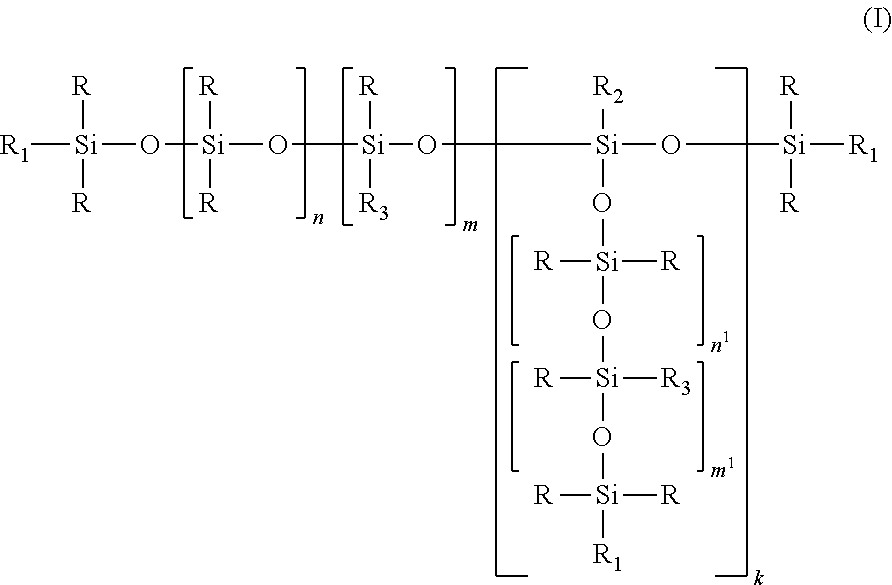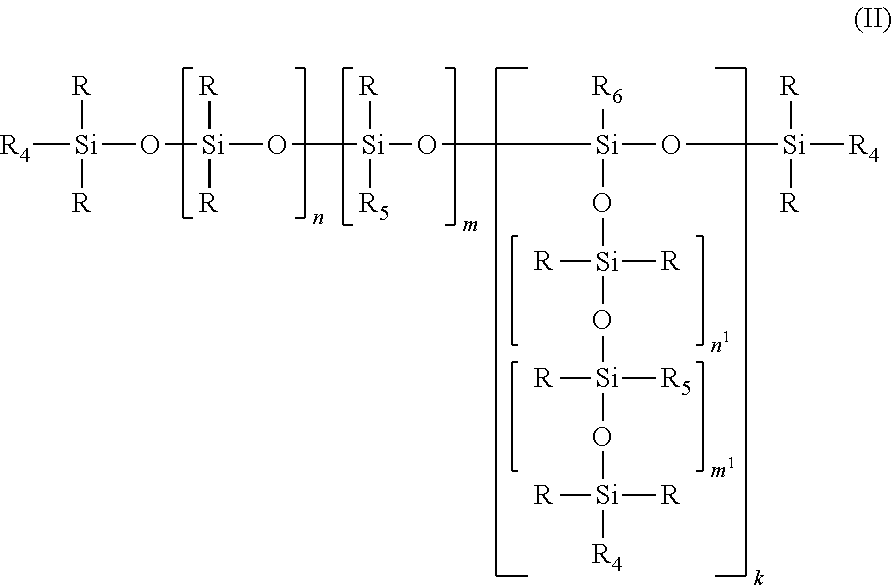Polysiloxane polyether copolymers having (polyether)moieties comprising carbonate groups and their use as stabilizers for the production of polyurethane foams
a polyether and carbonate group technology, applied in the direction of group 4/14 element organic compounds, organic chemistry, silicon organic compounds, etc., can solve the problems of unsuitable silicone stabilizers, significant performance differences, and work-up of intermediates and catalyst systems, so as to achieve good compatibility between blowing agent and stabilizer, the effect of less tendency to coagulation
- Summary
- Abstract
- Description
- Claims
- Application Information
AI Technical Summary
Benefits of technology
Problems solved by technology
Method used
Image
Examples
example 1
Production of Polyethers Having Carbonate Structure
[0063]30.03 g of triethylene glycol, 47.3 g of diethyl carbonate and 0.1 g of butyl titanate were weighed into a single-necked flask and heated at reflux (Toil=155° C.). Removal of distillate began after 2.5 hours. The distillate involved ethanol which was liberated during the reaction and which was discarded. Once distillation was complete, 20.4 g of allyloxyethanol and 0.1 g of butyl titanate were added and the mixture was again heated at reflux with an oil-bath temperature of 155° C. Once the further distillate produced had been removed, a vacuum of 300 to 500 mbar was applied and finally drying was completed at 20 mbar. The product was a yellowish-brownish liquid, which became clear after filtration through a round WeiBband filter paper.
[0064]The molecular weights Mn and Mw were determined by gel permeation chromatography under the following measurement conditions: column combination SDV 1000 / 10 000 Å (length 65 cm), temperature...
example 2
Production of Polyurethane Foams by Manual Foaming Using Stabilizers Which Comprise Polyethers Having Carbonate Structure and Using a Comparative Stabilizer
[0070]The following formulation was used for the production of the polyurethane foams: 100 parts by weight of polyetherol (hydroxy number=48 mg KOH / g, 11-12% EO), 5 parts by weight of water, 5 parts by weight of methylene chloride, 0.6 part by weight of the silicone stabilizers produced using inter alia the polyether polysiloxane examples given in Table 2 having carbonate structure, 0.15 part by weight of a tertiary amine, 64.2 parts by weight of T 80 toluene diisocyanate (Index 115) and also 0.23 part by weight of KOSMOS® 29 (Evonik Industries AG). The foam process used 300 g of polyol, and the amounts of the other formulation constituents were converted accordingly.
[0071]For the foaming process, the polyol, water, amine, tin catalyst and silicone stabilizer were thoroughly mixed, with stiffing. After addition of methylene chlor...
example 3
Production of Polyurethane Foams by Co2 Foaming Using Stabilizers Which Comprise Polyethers Having Carbonate Structure and Using a Comparative Stabilizer
[0072]The following formulation was used for the production of the polyurethane foams using CO2 as a blowing agent: 100 parts by weight of polyetherol (hydroxy number=48 mg KOH / g), 6 parts by weight of water, 0.8 part by weight of silicone stabilizer, 0.11 part by weight of a tertiary amine (TEGOAMIN® B75 from Evonik Industries AG), 68.6 parts by weight of T 80 toluene diisocyanate (Index 105), and also 0.18 part by weight of KOSMOS® 29 (Evonik Industries AG) and 3.07 parts by weight of CO2.
[0073]The foaming process was carried out with the aid of a NovaFlex system. Polyol output was set at 4500 g / min, and the amounts used of the other formulation constituents were converted accordingly.
[0074]A sieve set with four sieves was used, with permeability and hole size defined as follows: sieve I: 16% permeability with a hole size of 85μ, ...
PUM
| Property | Measurement | Unit |
|---|---|---|
| pressure | aaaaa | aaaaa |
| temperature | aaaaa | aaaaa |
| molar mass | aaaaa | aaaaa |
Abstract
Description
Claims
Application Information
 Login to View More
Login to View More - R&D
- Intellectual Property
- Life Sciences
- Materials
- Tech Scout
- Unparalleled Data Quality
- Higher Quality Content
- 60% Fewer Hallucinations
Browse by: Latest US Patents, China's latest patents, Technical Efficacy Thesaurus, Application Domain, Technology Topic, Popular Technical Reports.
© 2025 PatSnap. All rights reserved.Legal|Privacy policy|Modern Slavery Act Transparency Statement|Sitemap|About US| Contact US: help@patsnap.com



